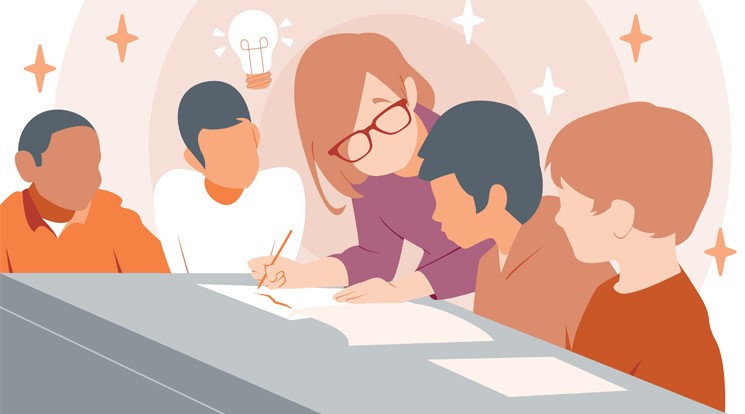The brain and whole-child education

Nestled in the cranium, the human brain is a dynamic, living system — a malleable organ that grows, rewires and adapts in response to experiences and interactions.
The brain plays a key role in learning. However in education settings, the focus is usually more on what to teach and how to teach it — not on how the brain learns. To better connect research in neuroscience, psychology and human development with learning, the Center for Whole-Child Education (formerly known as Turnaround for Children), has developed resources and tools to help educators apply what’s called the science of learning and development.
Now based at ASU’s Mary Lou Fulton College for Teaching and Learning Innovation, the center is dedicated to collaborating with educators, school systems and education nonprofits to apply these research-based approaches to help create effective learning environments. The center’s director, Tami Hill-Washington, provides insight into the scientific research that is the foundation of whole-child learning, which is also part of a new course being offered through the ASU Professional Educator Learning Hub.
How do you define whole-child education?
Whole-child education is based on the understanding that learning is an integrated process. Research shows that cognitive processes like memory, attention and problem-solving are influenced by emotional states. Feelings of safety or stress, and social factors, such as peer relationships and teacher-student dynamics, all contribute to our emotional states. In the brain, this means that students are simultaneously building anatomically cross-wired and interconnected neural networks that facilitate skills like self-regulation while also helping them think, learn and remember content knowledge.
Over the years, the field of education has seen the emergence of concepts intended to support the whole child such as restorative justice, community schools and social-emotional learning. In addition to embracing that as whole-child work, we saw a need to provide a unifying approach that can be used with any learning setting, curriculum or initiative. We saw a need to re-establish the link between scientific evidence and the case for whole-child approaches to teaching and learning. With input from community stakeholders, we have developed a whole-child framework, guiding principles and resources for educators and education systems to help identify, assess and scale effective whole-child approaches.
What does the science of learning and development tell us about supporting the whole child?
A whole-child approach recognizes that children’s well-being and learning are inseparable, and it is backed by the latest research from the science of learning and development. The science of learning and development is an interdisciplinary field that draws from various domains — such as neuroscience, developmental psychology, and education — to understand how human beings grow, learn and develop, particularly in childhood and adolescence. Research has shown that human development is a complex, context-dependent process, influenced by relationships, environment and biological factors. Understanding the malleability of the brain and the dynamic nature of learning offers opportunities to create supportive environments that optimize children's developmental outcomes into adulthood.
What role does adversity, such as trauma or chronic stress, have in a child’s development?
Researchers have found that adversity and chronic stress can lead to profound impacts on a child’s development, particularly on brain architecture. Prolonged exposure to stress can disrupt the development of critical brain regions responsible for self-regulation, memory and executive function — skills that are essential for learning. Adverse childhood experiences, like trauma, abuse or neglect, increase the risk of a variety of long-term health and developmental problems, including mental health disorders and learning difficulties.
What is the role of relationships in countering these factors?
Relationships play a foundational role in child development. Positive and supportive relationships contribute to healthy brain architecture, helping children build critical skills like self-regulation and executive function. The ability of caregivers and teachers to attune to a child's internal states provides emotional security and creates conditions where children are better able to engage in learning.
These relationships can buffer the effects of stress and adversity, as they physically “turn down’” the damaging effects of the stress hormone, cortisol. This process plays out in the brain through neural plasticity, which allows the brain to change and reorganize in response to new experiences and learning opportunities. This flexibility is essential for learning and adaptation, highlighting that development is not linear but varies across individuals and contexts.
What does this mean for individual learners and education systems?
Each child’s developmental pathway is unique, shaped by their specific context, experiences and interactions. There is no single "ideal" developmental pathway, no “average” student, and acknowledging individual variability is crucial for supporting personalized learning and growth. This understanding has implications for education and interventions, which should address a wide range of abilities and needs and be tailored to meet the unique needs of each child. The research reinforces the need for a more systemic approach to creating teaching and learning environments that foster strong relationships, buffer stress and promote both emotional and cognitive development.
______________________________________________________________________
Learn more
Professional learning courses
The Center for Whole-Child Education is launching a series of courses for educators, available through the ASU Professional Educator Learning Hub:
- Whole-Child Education: From science to practice. Available Now
- The Brain and Body in a Classroom: Using science to design learning environments. Launching soon.
- Beyond Being Nice: The science of relationships. Launching soon.
Toolbox
Additional resources include a toolbox designed for educators – teachers, school and district leaders, student support staff and more – to drive change towards a more equitable, whole-child approach to school. It includes the Whole-Child Design Blueprint, student strategies and measurement/scoring tools, such as the “well-being index.” (created when the center went by the name Turnaround for Children). Access the toolbox.
Watch this video on the Science of Learning and Development.
Featured interviews include Pamela Cantor, the founder of Turnaround for Children prior to it becoming the Center for Whole-Child Education at MLFTC: